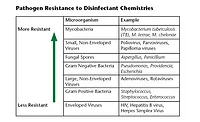Balancing Safety & Effectiveness: Hydrogen Peroxide-Based Cleaners in Crime & Trauma Scene Restoration

When cleaning-up a trauma scene, visual inspection for tiny droplets of blood can be challenging. This is particularly true when the potentially affected surface has an irregular pattern, as is common in building materials such as stone or decorative wood, or when the surface is a dark color. Spraying with a diluted solution of hydrogen peroxide can make the task of finding and cleaning blood spatter much easier.
The reason hydrogen peroxide (also referred to as peroxide) foams when exposed to blood is that it reacts with catalase, an enzyme found in blood and other cells. During the reaction with catalase, oxygen atoms separate from the peroxide molecules, producing oxygen bubbles and water. Surfactants in peroxide-based cleaners work synergistically with the bubbles to break up organic stains and form a foamy emulsion of cells and other blood components that is more easily wiped or rinsed away.
But the instability that makes peroxide a good cleaner can also work against you. Unless the cleaner is stored properly, the peroxide may decompose in the bottle and render the cleaner much less effective within a short time frame. And even in ideal storage conditions, unless the formulation is adequately stabilized, it may still break down before you use it up. Buying a product with a higher concentration is not necessarily the best way to address peroxide decomposition, since more peroxide can pose a threat to you and your crew. So what do you need to look for and do to get the most out of a peroxide-based cleaner?
Select a concentration for both safety and utility
A cleaner that contains 6% or 7% peroxide will have plenty of cleaning power and is great for cleaning blood from concrete and other construction materials. In most forensic restoration jobs, you will not need a more concentrated peroxide solution and you’ll save money by not paying the fees associated with shipping a HAZMAT. Solutions containing 8% peroxide or higher are classified as HAZMAT and will require more specialized PPE and greater attention to how the product is handled and used.
Stronger is not necessarily better, and concentrations higher than 8% will expose you and your team to more risk. Even though hydrogen peroxide is viewed as an environmentally friendly ingredient, the current TLV (Threshold Limit Value) is 1 ppm (1 part peroxide per million parts of air, averaged over an 8 hour shift), because peroxide can do a lot of damage to your eyes and lungs. When working with high concentrations, use a full face respirator with the appropriate cartridges and protect your skin with chemical resistant gear.
Keeping your peroxide fresh
Three environmental conditions can cause your peroxide cleaner to decompose prematurely:
• UV light
• Elevated temperature
• Agitation
Although some manufacturers conduct testing that involves trucking their products across the desert, you’ll get the most out of your peroxide-based cleaner if you store it at room temperature, away from sunlight, until you’re ready to use it.
Diluting peroxide
When using peroxide to detect blood spatter, a concentration of 1% to 2% will generate enough foam to be seen easily. You can use a 7.5% peroxide cleaner for detecting blood, but if you’ll put 8 ounces of that cleaner into an empty 32 ounce bottle, then fill it with clean water, you’ll have a 1.8% peroxide solution and your one gallon bottle of 7.5% peroxide will make 5 gallons of blood detection spray. Several important considerations when diluting peroxide:
- It is best to dilute just before you plan to use it. Stabilized peroxide solutions are made with a very precise balance of hydrogen peroxide, stabilizers and other ingredients. When you dilute the solution with water, you change the equilibrium and the solution will not be as stable.
- Dilute with water that doesn’t contain dissolved minerals. The dissolved minerals in hard tap water can react with the peroxide and cause it to weaken. Manufacturers blend with deionized water to maximize the stability of their peroxide solutions. If your tap water is hard, consider diluting as close to the time of use as possible, or you may want to dilute with reverse osmosis treated water. If your tap water contains very little dissolved minerals, you may be able to dilute several days or weeks before you plan to use it.
- Pour from the original bottle into the container that will hold the diluted solution. Don’t add water to the original bottle of cleaning solution unless you plan to use it soon. Water will change the equilibrium and cause your cleaning solution to grow weaker with time.
Peroxide that lasts longer
Stabilizing technology has come a long way since brown bottle drug store peroxide was first introduced. Peroxide-based cleaners with a shelf life of 3 years from the date of manufacture enable local distributors to keep more product on the shelf without being concerned that it will expire before it is purchased and that the peroxide will be at full strength when it is used on your job site.
To sum it up
A stabilized hydrogen peroxide cleaner with a concentration of 6-7% is strong enough to clean crime and trauma scenes, but safer to use than solutions that contain more peroxide. When diluting down to 1-2% peroxide for detecting blood spatter, use the cleanest water available and dilute as close to the time of use in order to avoid degradation of your solution. Examine the expiration date on the bottle to ensure that the solution you’re purchasing is full strength. To keep your peroxide at full strength, store it away from sunlight in a cool place.
Please direct questions or comments to Stephen Leung.
Looking for a reprint of this article?
From high-res PDFs to custom plaques, order your copy today!






